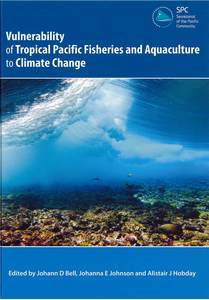Vulnerability of freshwater and estuarine fisheries in the tropical Pacific to climate change
Gehrke, Peter C., Sheaves, Marcus J., Boseto, David T., Figa, Boga S., and Wani, Jacob (2011) Vulnerability of freshwater and estuarine fisheries in the tropical Pacific to climate change. In: Bell, Johann D., Johnson, Johanna E., and Hobday, Alistair J., (eds.) Vulnerability of Tropical Pacific Fisheries and Aquaculture to Climate Change. Secretariat of the Pacific Community, Noumea, New Caledonia, pp. 577-646.
![[img]](https://researchonline.jcu.edu.au/19650/1.hassmallThumbnailVersion/19650_Gehrke_et_al_2011_Book_Cover.jpg)
|
Image (JPEG) (Book Cover)
- Cover Image
Download (226kB) |
|
|
PDF (Published Version)
- Published Version
Restricted to Repository staff only |
Abstract
The freshwater and estuarine fisheries in the tropical Pacific are poorly understood compared to the oceanic and coastal fisheries of the region (Chapters 8 and 9). Yet freshwater and estuarine fisheries are more important than most people realise – catches from freshwater habitats alone contribute 4% of regional gross domestic product (GDP) derived from all fisheries resources. This contribution is remarkable, given that freshwater fish habitats account for such a small proportion of the land area of Pacific Island countries and territories (PICTs), and that the land itself represents only 1.8% of the total area of the territorial waters and exclusive economic zones of PICTs (Chapter 1). Because of the predominance of high islands in Melanesia (Chapter 1), most of the freshwater fish production comes from Papua New Guinea (PNG), with significant harvests also being made in Fiji and Solomon Islands.
Recent preliminary estimates indicate that the total production of freshwater fish from the region is ~ 24,000 tonnes per year. The significance of this production is apparent when it is compared with the total catch of freshwater fish in Australia, which is estimated to average about 300 tonnes per year for commercial fisheries, and around 4000 tonnes per year for recreational fisheries.
The estimates of freshwater and estuarine fish catches for the region are preliminary, but these catches undoubtedly form an important part of the diet for people in inland rural areas. Indeed, freshwater fish are the most common source of animal protein for communities with access to freshwater and estuarine habitats in PNG. For example, villagers along parts of the Fly River eat as much as 2 kg of fish per person each week. This compares with the highest levels of per capita fish consumption (> 100 kg per person per year) by coastal communities in the region (Chapter 1). Clearly, any alteration in freshwater and estuarine fish production as a result of climate change has potential to affect the food security and livelihoods of people in the inland areas of the region.
In this chapter, we assess how the projected changes to surface climate (Chapter 2) and sea level (Chapter 3), and the anticipated alterations to fish habitats (Chapter 7), are likely to affect freshwater and estuarine fisheries. Because of the limited information available, and the inherent uncertainty that stems from the complex ways in which freshwater and estuarine fish interact with their habitats and other species, this chapter represents a starting point for more detailed investigation rather than a definitive analysis of vulnerability.
We begin by describing the main species of fish and invertebrates harvested from freshwater and estuarine habitats in the tropical Pacific and the ways in which they are used, and then summarise recent catch levels, status of stocks and estimates of sustainable production. To assess the vulnerability of the resources, we use the framework described in Chapter 1 to outline how the main groups of fish species are directly exposed to projected changes in surface climate and sea level, and how they are indirectly exposed through changes to the habitats on which they depend for food, shelter and reproduction. We also evaluate their sensitivity to these changes, and their capacity to adapt. These assessments are made for a low (B1) and a high (A2) emissions scenario10 for 2035 and 2100.
We conclude by examining the gaps in knowledge and the research required to address them, and by identifying the management measures needed to reduce the negative impacts and harness the possible opportunities for freshwater and estuarine fisheries likely to be associated with climate change.
| Item ID: | 19650 |
|---|---|
| Item Type: | Book Chapter (Research - B1) |
| ISBN: | 978-982-00-0471-9 |
| Date Deposited: | 21 Feb 2012 00:21 |
| FoR Codes: | 05 ENVIRONMENTAL SCIENCES > 0501 Ecological Applications > 050101 Ecological Impacts of Climate Change @ 100% |
| SEO Codes: | 96 ENVIRONMENT > 9603 Climate and Climate Change > 960309 Effects of Climate Change and Variability on the South Pacific (excl. Australia and New Zealand) (excl. Social Impacts) @ 100% |
| Downloads: |
Total: 556 Last 12 Months: 4 |
| More Statistics |



